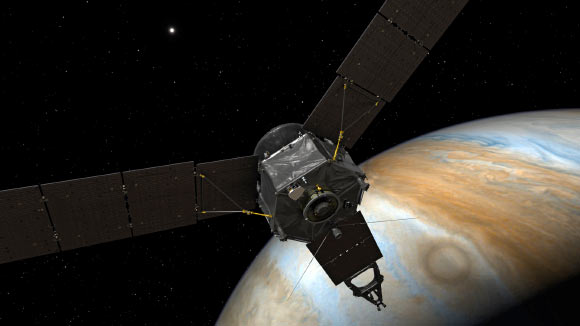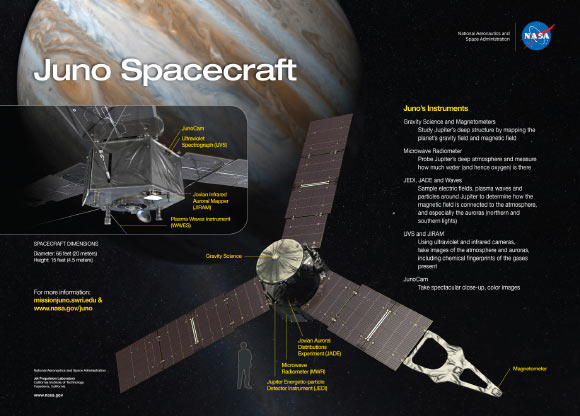NASA’s Juno spacecraft will arrive at Jupiter, the most massive planet in our Solar System, later today (July 4) to orbit the gas giant for 20 months and collect data on the planetary core, map the magnetic field, and measure the amount of water and ammonia in the Jovian atmosphere.

This illustration depicts NASA’s Juno spacecraft at Jupiter, with its solar arrays and main antenna pointed toward the distant Sun and Earth. Image credit: NASA / JPL-Caltech.
During the orbit-insertion phase, Juno will perform a series of steps in preparation for a main engine burn that will place it into orbit around the king of planets.
On July 4 at 6:16 p.m. PDT (9:16 p.m. EDT; 1:16 a.m. UTC/July 5), the solar-powered spacecraft will begin to turn slowly away from the Sun and toward its orbit-insertion attitude.
Then 72 minutes later, it will make a faster turn into the orbit-insertion attitude.
At 7:41 p.m. PDT (10:41 p.m. EDT; 2:41 a.m. UTC/July 5), Juno switches to its low-gain antenna. Fine-tune adjustments are then made to the spacecraft’s attitude.
Twenty-two minutes before the main engine burn, at 7:56 p.m. PDT (10:56 p.m. EDT; 2:56 a.m. UTC/July 5), the spacecraft spins up from 2 to 5 revolutions per minute to help stabilize it for the orbit insertion burn.
At 8:18 p.m. PDT (11:18 p.m. EDT; 3:18 a.m. UTC/July 5), Juno’s 35-minute main-engine burn will begin. This will slow it enough to be captured by the gas giant’s gravity.
The burn will impart a mean change in velocity of 1,212 mph (542 m a second) on the spacecraft.
After the main engine burn, Juno — launched almost five years ago — will be in orbit around Jupiter.
The spacecraft will spin down from 5 to 2 revolutions per minute, turn back toward the Sun, and ultimately transmit telemetry via its high-gain antenna.
Juno starts its tour of Jupiter in a 53.5-day orbit. The spacecraft saves fuel by executing a burn that places it in a capture orbit with a 53.5-day orbit instead of going directly for the 14-day orbit that will occur during the mission’s primary science collection period.
The 14-day science orbit phase will begin after the final burn of the mission for Juno’s main engine on October 19.
“We are ready. The science team is incredibly excited to be arriving at Jupiter,” said Dr. Scott Bolton from the Southwest Research Institute, principal investigator of Juno.
“The engineers and mission controllers are performing at an Olympic level getting Juno successfully into orbit.”
“As Juno barrels down on Jupiter, the scientists are busy looking at the amazing approach science the spacecraft has already returned to Earth.”
“Jupiter is spectacular from afar and will be absolutely breathtaking from close up.”
During its mission of exploration, Juno will circle Jupiter 37 times, soaring low over the giant planet’s cloud tops — as close as about 2,600 miles (4,100 km).
During these flybys, the spacecraft will probe beneath the obscuring cloud cover of Jupiter and study its auroras to learn more about the planet’s origins, structure, atmosphere and magnetosphere.








